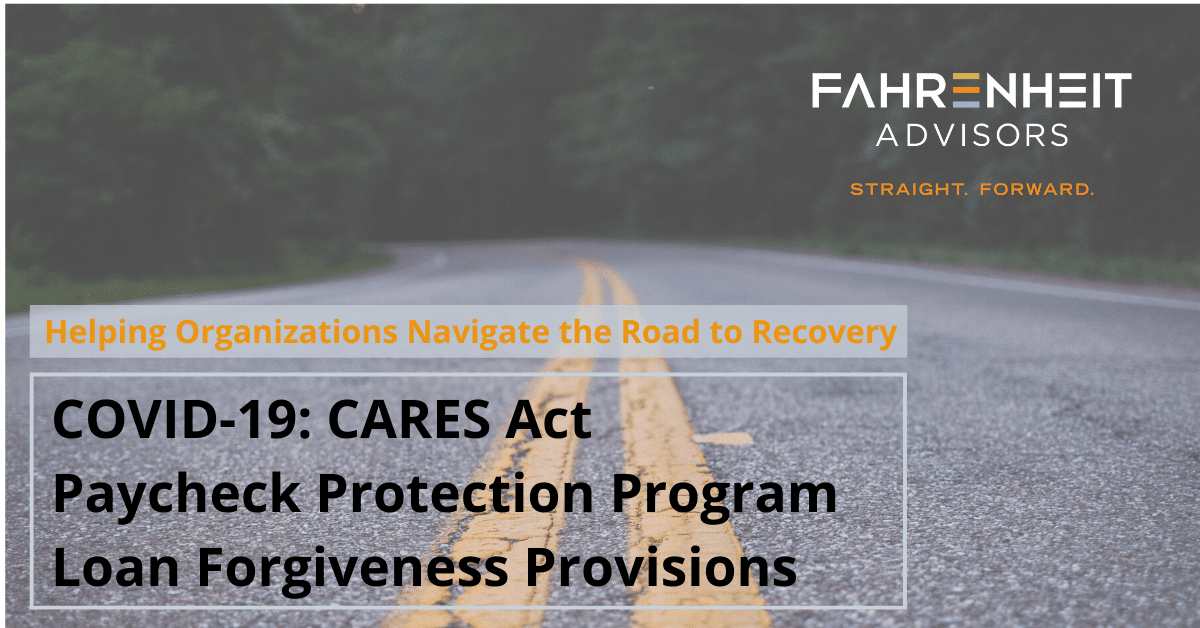COVID-19: CARES Act Paycheck Protection Program Loan Forgiveness Provisions
 As companies move beyond the CARES Act Paycheck Protection Program application process, they will turn towards how to calculate the loan forgiveness amount. While the Act has a lot of specifics and some guidance has been issued by the SBA, the SBA has stated several times that it will issue additional guidance. As companies begin to think about how to pull data, calculate the amount and prepare information to be submitted with the loan forgiveness application, as seen with the PPP loan itself, things may change as additional guidance is issued. In addition, consistent with the PPP applications, there is reason to believe each bank may require different information and in different formats. Remember, companies will have eight weeks from loan origination before they will have to calculate and submit the loan forgiveness application.
As companies move beyond the CARES Act Paycheck Protection Program application process, they will turn towards how to calculate the loan forgiveness amount. While the Act has a lot of specifics and some guidance has been issued by the SBA, the SBA has stated several times that it will issue additional guidance. As companies begin to think about how to pull data, calculate the amount and prepare information to be submitted with the loan forgiveness application, as seen with the PPP loan itself, things may change as additional guidance is issued. In addition, consistent with the PPP applications, there is reason to believe each bank may require different information and in different formats. Remember, companies will have eight weeks from loan origination before they will have to calculate and submit the loan forgiveness application.
What we think we know at this point.
Companies should make sure they are able to accumulate certain data during the eight-week period (the “covered period”) beginning from the date of loan origination (defined as the date of first funding into the borrower’s bank account). While the accumulation of this data should be simple in theory, some companies may not have the reporting in place to pull the data easily.
Use of loan proceeds and loan forgiveness
As previous guidance outlined, it is expected that at least 75% of loan proceeds should be utilized for payroll costs. The guidance also anticipates that a similar benchmark will be used for the loan forgiveness calculation and approval in which not more than 25% can be for non-payroll costs.
Basis of accounting
Currently there are differences of opinions on how the SBA (and potentially the banks) will interpret and apply the accounting for the allowable costs during the eight-week period that will be used in the loan forgiveness calculation. Companies should be prepared to track both at this point. Our assumption is additional guidance will be issued by the SBA or at the bank level. The two current opinions:
- Cash basis – the allowable costs will be based on actual cash outflows during the eight-week period, i.e. actual payroll and rent paid. Under this scenario, banks would obtain the payroll registers for the payrolls during the eight weeks and tick and tie the dates and amounts. Amortization of a prepaid would not count.
- Accrual basis – using the accrual basis of accounting, the allowable costs will be based on the costs incurred during the eight-week period even if the actual cash is not paid until after the eight-week period, i.e. payroll period ends on the 30th, which corresponds with the end of the 8 week period, but the cash is not disbursed until the following week. In this scenario, the bank would have to understand the timing of the payroll periods and tick and tie to the post eight-week payroll register.
Loan forgiveness calculation – what’s included:
- Payroll costs – payroll costs are assumed to be defined the same as in the loan application. This would include gross salaries and wages, employer cost of employee benefits (health and retirement), and state and local taxes on compensation (just SUTA in Virginia); and continues to exclude gross salaries and wages over $100,000 per individual. (Note: while the Act specifies “payroll costs” only, the interpretation is that all other costs will be included based on the Interim Final Rule paragraph 2f definition.)
- Interest on mortgage obligations, not the principal portion, (means any indebtedness or debt instrument incurred in the ordinary course of business that is a liability of the borrower for a mortgage on real or personal property) (1)
- Rent payments obligated under a leasing agreement (1)
- Utility payments (defined as payments for a service for the distribution of electricity, gas, water, transportation, telephone or internet access) (1)
(1) only payments on mortgages (interest only), leases and utility agreements dated prior to or service began before February 15, 2020 may be included.
Reductions in loan forgiveness
NOTE: The Act as signed included a significant drafting error with regard to the forgiveness formula. We expect further guidance on this will be issued and the following is based on what we (and others) believe will be correct.
Loan forgiveness is intended to be reduced based on:
i. Reduction based on number of employees – if the average number of full-time equivalent employees per month employed is reduced during the covered period as compared to, at the borrowers option, one of the base periods below, then the amount of loan forgiveness will be reduced accordingly.
The average number of full-time equivalent employees shall be determined by calculating the average number of full-time equivalent employees for each pay period falling within a month.
Base period options – the average number of fulltime equivalent employees per month employed:
-
-
- during the period beginning on February 15, 2019 and ending on June 30, 2019, or
- during the period beginning on January 1, 2020 and ending on February 29, 2020, or
- in the case of a seasonal employer, as determined by the Administrator, during the period beginning on February 15, 2019 and ending on June 30, 2019.
-
The intent is that the amount of loan forgiveness shall be reduced (calculated) by the percentage equal to the difference obtained by subtracting from 1 (one) the quotient obtained by dividing the (i) the average number of full-time equivalent employees per month employed during the covered period by (ii) the average number of full time equivalent employees per month employed during the base period. For example,
-
-
- FTE’s during the covered period were 100
- FTE’s in the base period were 125
- Equals 80%
- 1 minus 80% = 20%
- Reduction in loan forgiveness would be 20%
- The 20% would be multiplied times the calculated amount of loan forgiveness
-
ii. Reduction in salaries and wages – the amount of loan forgiveness shall be reduced, dollar for dollar, by the amount of any reduction in total salaries and wages of any employee (defined below) during the Covered Period that is in excess of 25% of the total salary or wages of the employee during the most recent full quarter (13 weeks) prior to the Covered Period during which the employee was employed.
Only employees who were employed during any single pay period in 2019 and did not receive salary or wages at an annualized rate in excess of $100,000 during any single pay period in 2019 are included in this calculation.
So…. What we don’t know – this will take some further guidance:
How do you compare a 13-week period (full quarter) to an eight-week period? What will be the basis?
-
-
- For salaried – assumption may be if there was a reduction in salary over 25%, and then multiply that percentage times the salary for the eight weeks?
- For hourly – assumption may be calculated using an average pay rate per hour and if more than a reduction of 25%, multiply the amount over 25% times the compensation over the eight weeks? Or are they looking for total compensation reduction between periods?
-
Relief from Loan Forgiveness Reduction
The Act does provide relief, if by June 30, 2020, the company re-hires an employee or restores salary levels for any changes made between February 15, 2020 and April 26, 2020.
Specifically, the amount of loan forgiveness can exclude headcount or salary reductions that were made during the period from February 15, 2020 to April 26, 2020 if:
- During the period beginning on February 15, 2020 and ending on April 26, 2020, there was a reduction, as compared to February 15, 2020, in the number of full-time equivalent employees and not later than June 30, 2020, the employer rehired the employee; or
- During the period beginning on February 15, 2020 and ending on April 26, 2020, there was a reduction, as compared to February 15, 2020, in the salary or wages of one or more employees and not later than June 30, 2020, the employer restored the salary or wages of such employees. (It is not defined as if the restoration must be back to the original amount or such that it is not more than a 25% reduction.)
We do not expect that the final regulations will allow avoidance of a reduction in forgiveness simply by rehiring employees or restoring pay cuts in excess of 25% on June 30, 2020. We expect to see monthly averages used in the calculations.
Documentation required (as currently stated and may vary by bank)
An eligible recipient seeking loan forgiveness shall submit to the lender that is servicing the covered loan a loan forgiveness application, which shall include:
- Documentation verifying the number of full-time equivalent employees on payroll and pay rates for the periods the base period and covered period including:
- payroll tax filings reported to the Internal Revenue Service; and
- state income, payroll, and unemployment insurance filings
- Documentation, including cancelled checks, payment receipts, transcripts of accounts, or other documents verifying payments on covered mortgage obligations, payments on covered lease obligations, and covered utility payments
- A certification from a representative of the eligible recipient authorized to make such certifications that the documentation presented is true and correct; and
- The amount for which forgiveness is requested was used to retain employees, make interest payments on a covered mortgage obligation, make payments on a covered rent obligation, or make covered utility payments; and
- Any other documentation the Administrator determines necessary.
FORGIVENESS DECISION
Not later than 60 days after the date on which a lender receives an application for loan forgiveness, the lender shall issue a decision on the application.
TAXABILITY
Any amount of loan forgiveness shall be excluded from gross income.
Due to the rapidly changing regulations and program specifics, some items in this post may have changed since the publication date. Companies should continue to monitor the US Treasury and SBA websites for updates.
 About the Author
About the Author
Keith Middleton is a co-managing partner and co-founder of Fahrenheit Advisors. He oversees the delivery of the firm’s consulting and fractional financial management services, as well as risk management and operations. A seasoned corporate finance executive, Keith’s expertise in organizational strategy and a newfound passion for entrepreneurism has helped Fahrenheit expand across multiple service lines and geographies.
